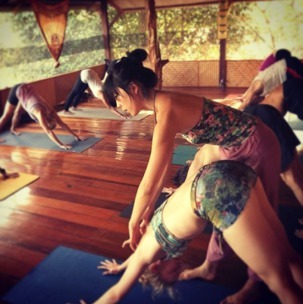A good enough adjustment just doesn’t make for an awesome one.
As yoga teachers, our job is to verbally instruct, visually demonstrate and physically align our students. The ability to cultivate two of the three makes a good teacher; the distance to make three out of three is what makes one, frankly, unforgettable.
Something about the sensation of touch, personal attention and care, I feel taken care of every time I receive a great adjustment in my Mysore practice.
Since I was young, I have the passion for human bodies. It fascinates me on so many levels. Not surprisingly it took me on many paths that directly related to it: dancing, personal training, yoga and Thai massage. In addition my bachelor’s degree in Human Kinetic provided me the foundation in human anatomy and sports medicine. All in all, whether conscious or subconscious, I’m passionate about human bodies and what they can do.
Now that I’m a full-time yoga teacher, I can’t help but fall straight in love with adjustment. I love the ability to visually identify what a student needs and help him/her into the correct alignment. It’s satisfying for both teacher and student.
For those who’ve had bad experiences with yoga adjustments, here are a few points I always go by:
1) Did the teacher respect your comfort zone?
This means, a teacher should never adjust without permission.
2) Did the teacher ask for feedback?
I always ask, “Is this ok?, Do you feel pain in the knee…shoulder…elbow…?” Without feedback, there is absolutely no way a teacher knows if the students are going beyond their limits.
3) Did the teacher adjust in accordance to your breath?
Simply said, an adjustment on simple alignment can be done on an inhale/exhale. However, when the teacher is trying to intensify a posture (going deeper in forward bending or rotating the femur in bilateral stretches) it is always on an exhale.
4) Was the grip pain free?
The hands of the adjuster should be positioned so that no flesh is being pinched and no bruises are made. I use a three-fingers adjustment. Instead of using the whole palm, only three fingers are applied, with the exception of inversions and twists.
5) Lastly, did you feel safe?
Adjustment is very intimate. It is based on a trusting relationship between student and teacher. Teachers must have the understanding and knowledge of safety and proper alignment. Then the students can relax and try progress in their practice.
I would never downplay yoga teachers who don’t believe in adjustments. I respect that. For me, the ability to articulate to the students through touch helping them progress in their practices makes adjustment an art. When I feel elation witnessing healthy postural changes, the wide smiles from the students and their outward gratitude, that makes adjustments to me a passion.
~
~
~
Love elephant and want to go steady?
Sign up for our (curated) daily and weekly newsletters!
~
~
Apprentice Editor: Marcee Murray King/Editor: Travis May
Photo: Courtesy of Author












Read 0 comments and reply